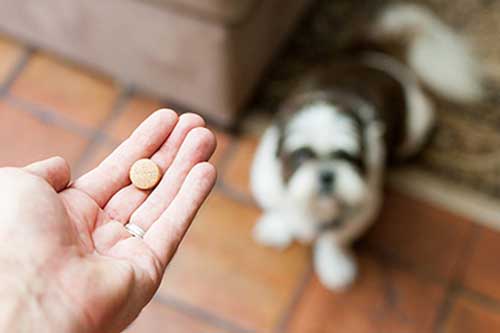How to Give Your Pet Medication

How to Give Your Pet Medication
When your dog or cat is hurt or sick, veterinarian‐prescribed medication medication may be part of their road back to health. Yet it can be a challenge to get a pet to swallow what’s good for them. Meds may have a bitter taste or a pet may balk at being force‐fed for its own good.
The first time you need to medicate your pet, ask the veterinarian to show you how to administer it so that you can follow the best practice.
Be sure that you understand the instructions and frequency of dosage as well as side effects that may occur. You’ll also want to know if there’s a particular time of day to deliver it. And ask how long to continue medicating and how soon you can expect your pet to respond.
When Pills Are Prescribed
The easiest way to give a pet a pill is by disguising it in food (as long as your veterinarian tells you to impart it with food rather than on an empty stomach). Pill Pockets are commercially made, tasty treats for cats and dogs than can hold a pill or capsule inside. You can also conceal a pill for a cat by enrobing it in cheese or another type of food that your cat likes. Or try making a tiny meatball out of wet cat food and embedding the medication in it. Dogs, who are more eager to swallow a variety of things, usually accept a pill if it’s disguised as a treat. Coatings and wraps that usually work are cream cheese, peanut butter, meat and meat-flavored baby food. Once you’ve prepared the pill, you may need to restrain your pet to deliver it. With a cat, wrap him in a towel, leaving his head exposed. That will prevent him from escaping or scratching you. Hold him in your lap or sit with him between your legs. Press at his cheekbones to open his jaw and insert the pill as far back as possible. Then close his mouth and massage his throat to encourage swallowing. To give a dog who won’t accept a medicated treat a pill, get down on the floor with him or put him on a table with a non-slip surface. Hold his upper jaw open and tilt his head back. Position his upper lip over his top teeth to avoid getting bitten and drop the pill on the base of his tongue. Then close his mouth and blow on his nose or rub his throat to get him to swallow.
Delivering a Pill Without Food
To give your pet a pill without sticking your fingers in its mouth, get a piller, also known as a pill gun or pill pusher. Veterinary offices and pet supply stores usually stock them. To use one, insert the pill at the open end, open your pet’s mouth, place the plunger near the back of your pet’s throat (side entry may be easiest), push the plunger down and quickly remove it. Then hold your pet’s mouth shut, tilting it toward the ceiling and massaging her neck.
When LIquid Medication Is Prescribed
Try mixing the medication with a bit of your pet’s regular canned food. If he rejects that, you’ll need to use a dropper or syringe. To make it appealing, rub a tasty treat on the outside of the device and invite him to lick it. Then tilt your pet’s head back slightly and place the unit between his cheek and back teeth. Release the medication slowly to that area, allowing your pet time to swallow and breathe. Avoid squirting down your pet’s throat. Gently rub his throat to facilitate swallowing. Afterwards, pet your furbaby, tell him what a good boy he’s been, offer him a real treat and make water available.
When Your Pet Won't Take The Medicine
Don’t make your pet and yourself miserable if she rejects her meds. Ask your veterinarian if the medication can be provided in a different form.
Pet Care Tips Listing
- Things to Know About Pet Diabetes
- Things to Know About Dog and Cat Arthritis
- How to Prevent Your Dog from Biting: Child Safety Tips
- How to Keep Your Dog Mentally Active
- 5 Things to Ask at Your Pet’s First Vet Appointment
- How to Deal with Kidney Failure in Dogs
- What to Do If You See Wildlife on The Road
- 5 Things You Need Before Bringing a Kitten Home
- Fleas: Causes and Prevention for Dogs
- What to Look for in a New Vet?
- How to Stop Cats from Scratching Furniture
- Questions to Ask Your Vet About Your Senior Dog in NSW
- What is separation anxiety?
- 4 Mistakes to Avoid When Training Your Dog
- Choosing Teeth-Friendly Treats for Your Pets
- How to Prepare for Camping with Your Dog
- Maintaining Good Oral Hygiene in Your Pets
- How to Know if Your Dog Has Worms and What to Do
- How to Give Your Pet Medication
- 4 Signs Your Cat Should See a Vet
- Human Food Safety for Dogs: What Foods to Avoid
- Why You Need to Vaccinate Your Puppy Before You Walk It
- How to Potty Train Puppies
- Why Should You Vaccinate Your Cat?
- What Does It Mean If Your Puppy is Limping?
- Expert Dog Swimming Tips by Kirrawee Vet
- How Often Does Your Puppy Need a Bath?
- How to Keep Your Aging Dog Comfortable
- Common Preventable Diseases in Dogs
- Common Feline Musculoskeletal Disorders
- Why Should You Vaccinate Your Dog?
- Patellar Luxation in Dogs – Expert Care in NSW
- Musculoskeletal Disorders in Dogs
- Osteoarthritis in Dogs
- Causes and Treatment of Hip Dysplasia in Dogs
- Do Dogs Need Regular Dental Care?
- Breeds of Dogs That Need the Most Exercise?
- What to Feed Fluffy? Dry or Wet? Both?
